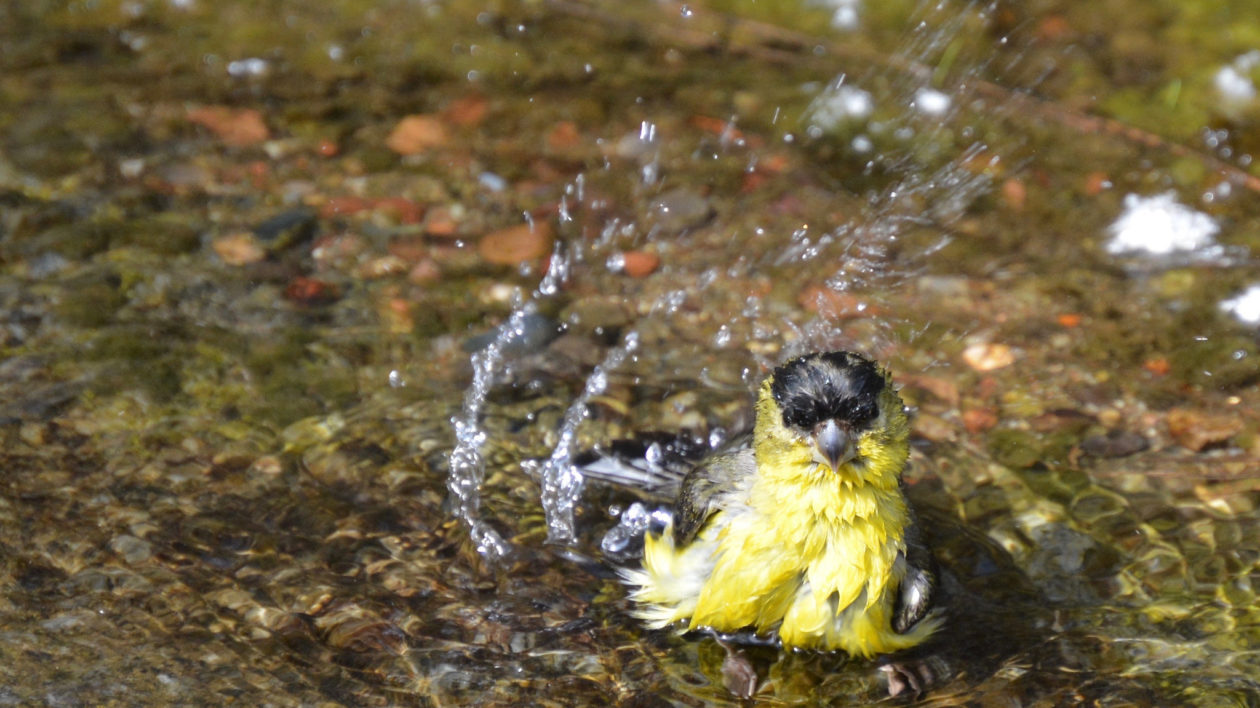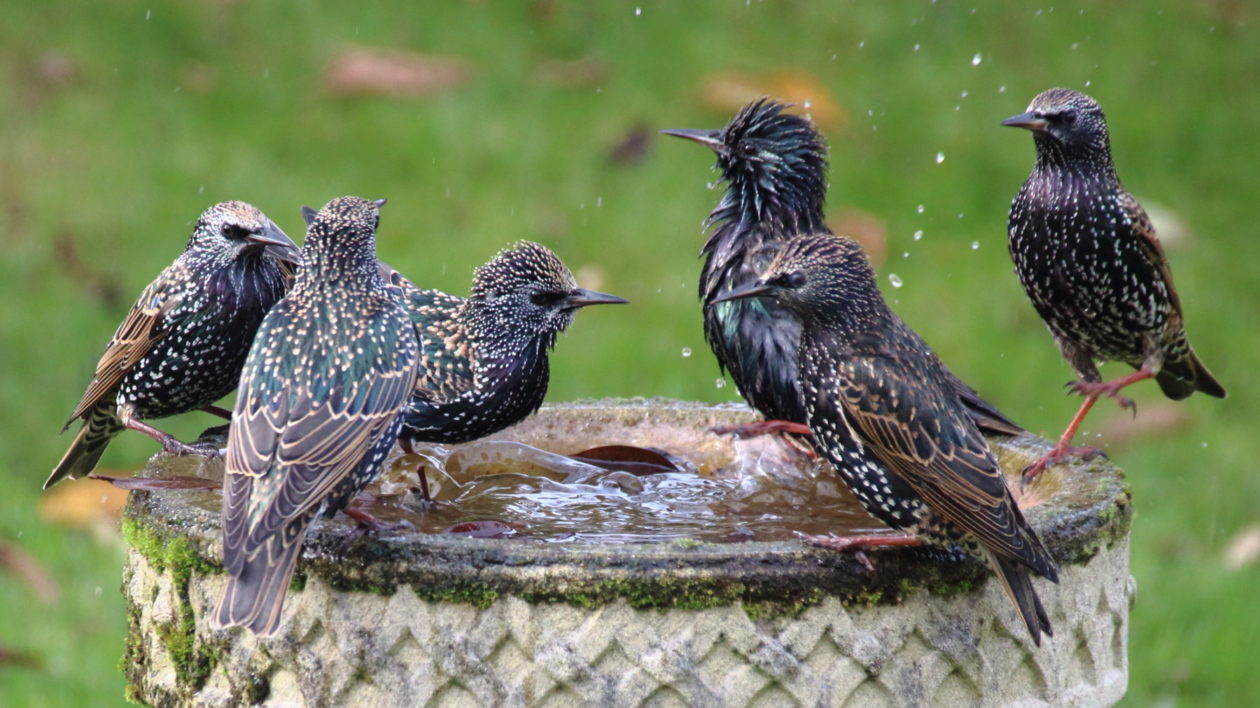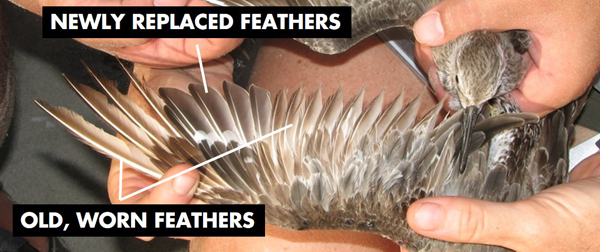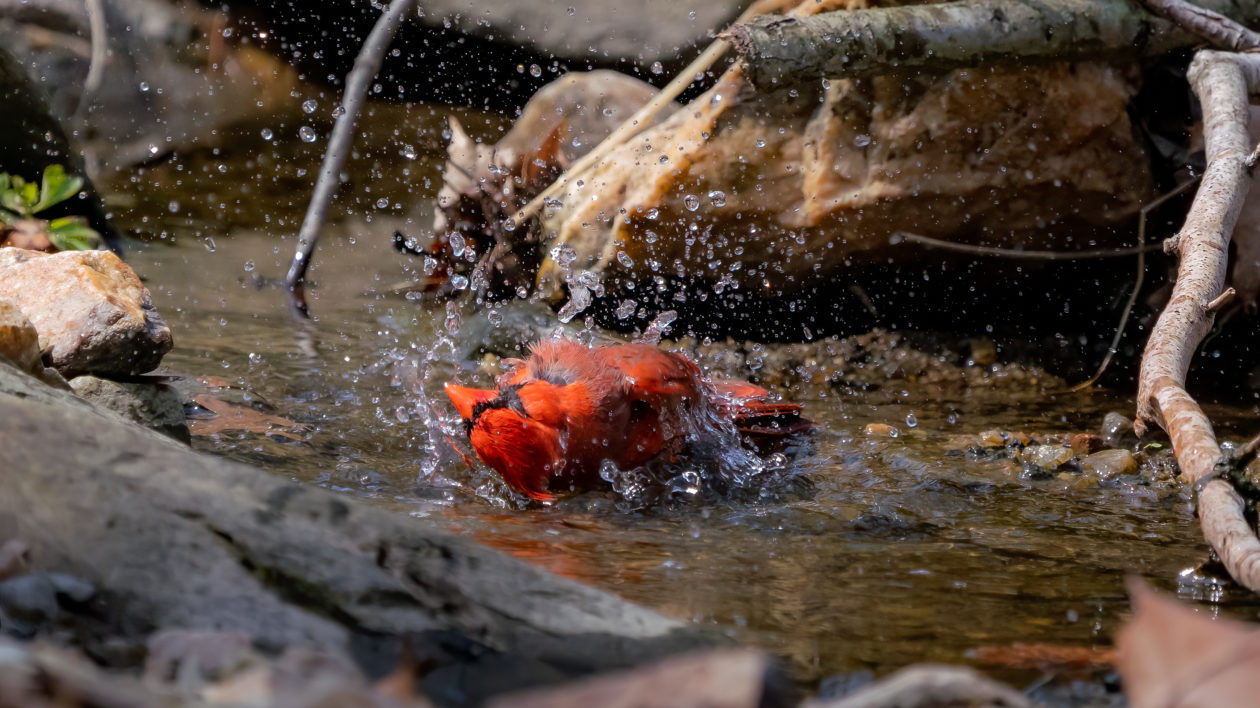Rub-a-Dub-Dub, Many Birds in the Tub
Although we are unaware of the purpose and significance of baths for birds, we are all aware that birds, like humans, enjoy having access to water for drinking and bathing.
I first realized how important bathing is to birds when I worked with migrant birds in the Yucatan Peninsula. We were studying warblers that were typically territorial. At our mangrove study sites, these birds regularly assumed threat postures and even got into fights to maintain the boundaries between their exclusive home ranges.
But there was a nightly truce at a public bird bath.

Every evening at dusk, a large number of American redstarts, northern parulas, magnolia warblers, common yellowthroats, and yellow warblers took turns bathing in a unique location in the mangroves where a freshwater spring bubbled up from the ground.
They shared this small haven one by one before retiring for the evening.
The peaceful way territorial warblers alternately bathe indicates that, for a bird, having access to water for bathing is worth putting one’s aggressive tendencies on holdat least for a short while.

Why Birds Take Baths
So, whats so important about a bath?
One hand can count the number of pertinent scientific articles. The mechanics of bird bathing in North American and Australian birds are described in very basic terms. Wet and dry drying of disembodied feathers is examined experimentally in two recent studies, and captive starlings were experimentally deprived of bath water in two of the studies.
These studies imply that bathing is crucial for feather maintenance even though the exact purposes of bird bathing are currently unknown.
A bird’s feathers are its lifeblood because they allow for insulation, waterproofing, and, of course, flight.
Feathers get replaced once or twice a year. They must be maintained in good shape in the interim. Feathers are weakened by the sun, bacteria, mites that eat feathers, and wear and tear over time. A set of flight feathers that are a year old appear to have been through a lot: they are dull and frayed.

For as long as possible, a good bath could keep those priceless feathers in the best possible condition.
Our knowledge of captive starlings has advanced somewhat as a result of two recent studies. Brilot and associates postulated in a study that denying a bird a bath would cause its feathers to become more disheveled, which would impair its ability to fly.
Two groups of starlings were tested: one that had just been bathed, and the other that had not had a bath for three hours before the experiment. When flying through an obstacle course made of strings hung vertically, the starlings without access to water were less coordinated and collided with more strings while in flight.
The research team looked at whether the starlings without baths realized they were more clumsy in their second paper on starlings. To achieve this, they simultaneously played recordings of starling predator alarm calls and mouthwatering meal worms to groups of birds that had been bathed and those that had not.
The results of the experiment showed that even though the recorded call indicated the presence of a predator, birds that had access to bath water were more willing to lower their defenses and feed. The authors speculate that because the unbathed birds knew their ability to flee was compromised, they were more circumspect.
This research indicates that bathing improves a bird’s short-term flight agility and ability to elude predators in addition to long-term feather preservation.
These studies are useful, but we still don’t fully understand the purpose of bathing.
Does it help realign the tiny barbs that hold feathers together, does it help distribute protective oils, or does it enhance feather performance in some other way that makes these birds better flyers?
All of this makes me wonder about those Yucatan birds. Our study aimed to identify individual differences in habitat quality, primarily through assessing the birds’ food sources. We reasoned that birds in better condition would have a higher chance of surviving if they had access to more food.
Perhaps, though, we were overlooking a crucial component of habitat quality: availability of bathing water. Baths may be important for survival as well, as the starling research shows that depriving an unbathed bird of its bath could make it easier to catch.
We will have to rely on common sense and keep those backyard bird baths filled until science provides an answer.

 A cardinal seems incredulous that a sparrow is in his bath.To make your bird baths appealing, keep fresh water in themwhich means scrubbing the algae, droppings and dirt out every few days. Water should be no more than three inches deep, and its best to taper to that depth. Because their hollow bones make them very buoyant, birds have to splash about, dipping and diving, like in dodgeball, to get water on their skin. Shallow pools help with that. Birds also seem to like texture in the bath, so its best to add a few stones that they may step on or you can purchase a textured bath. A drip fountain or mister and the sound of water will attract birds, too. Place your bird bath in the shade to keep the water cooler and lessen algae growth and position it near shrubs or trees to which birds may escape or stop, preen and wipe their bill.
A cardinal seems incredulous that a sparrow is in his bath.To make your bird baths appealing, keep fresh water in themwhich means scrubbing the algae, droppings and dirt out every few days. Water should be no more than three inches deep, and its best to taper to that depth. Because their hollow bones make them very buoyant, birds have to splash about, dipping and diving, like in dodgeball, to get water on their skin. Shallow pools help with that. Birds also seem to like texture in the bath, so its best to add a few stones that they may step on or you can purchase a textured bath. A drip fountain or mister and the sound of water will attract birds, too. Place your bird bath in the shade to keep the water cooler and lessen algae growth and position it near shrubs or trees to which birds may escape or stop, preen and wipe their bill.
 These robins knew how to share.Of course, birds need water for basic life functions, but why bathe? Does it make them smell better? Feel better? Look better? While those all may be true, the real reasons include their need to cool off in high temperatures. Birds do not have sweat glands, but they still lose water through their skin via evaporation, with smaller birds needing to hydrate more often due to their higher surface-to-body ratio because of this. Just like our sweat or water from a dip evaporates and cools us, water evaporates and cools birds.
These robins knew how to share.Of course, birds need water for basic life functions, but why bathe? Does it make them smell better? Feel better? Look better? While those all may be true, the real reasons include their need to cool off in high temperatures. Birds do not have sweat glands, but they still lose water through their skin via evaporation, with smaller birds needing to hydrate more often due to their higher surface-to-body ratio because of this. Just like our sweat or water from a dip evaporates and cools us, water evaporates and cools birds.
 This titmouse was a little flippant.Water also helps birds clean and maintain their feathers, because, while feathers are replaced, theyre not replenished with a frequency that allows birds to neglect their care. Good feathers are necessary for flight, insulation and waterproofing. Birds cant get soaked, though, because that would impede their ability to fly and escape predatorswhich is probably why birds dont linger in the bath. Further, bathing removes dirt, bacteria and parasites. Eww, right? That alone should be reason enough to change the water in your bird baths often, even daily.
This titmouse was a little flippant.Water also helps birds clean and maintain their feathers, because, while feathers are replaced, theyre not replenished with a frequency that allows birds to neglect their care. Good feathers are necessary for flight, insulation and waterproofing. Birds cant get soaked, though, because that would impede their ability to fly and escape predatorswhich is probably why birds dont linger in the bath. Further, bathing removes dirt, bacteria and parasites. Eww, right? That alone should be reason enough to change the water in your bird baths often, even daily.
 A catbird seems to scold its mate at this water fountain.I enjoy watching the birds antics around watering holes, and the popularity of these stands of water made me wonder why birds bathe. Undoubtedly, they come to drink. Most birds dip their bill into the water and then tilt their heads back to allow gravity to carry the water into their belly. Some birds can use their tongue, like dogs and cats, to fill their bill with water, but then they must tip their head back to swallow. Doves and pigeons, however, can suck water while their heads are down.
A catbird seems to scold its mate at this water fountain.I enjoy watching the birds antics around watering holes, and the popularity of these stands of water made me wonder why birds bathe. Undoubtedly, they come to drink. Most birds dip their bill into the water and then tilt their heads back to allow gravity to carry the water into their belly. Some birds can use their tongue, like dogs and cats, to fill their bill with water, but then they must tip their head back to swallow. Doves and pigeons, however, can suck water while their heads are down.
Its been a hot summer. There were more 90-degree days in July than we have seen in a number of years, even in Western Pennsylvania. And even though we’ve had a little more rainfall than usual for the year thus far, our recent dry spell and high temperatures have made my bird bathor, as I like to call it, the bird wash”a popular hangout for our feathered guests.
FAQ
Are you supposed to give birds baths?
Do birds take water baths?
Do birds actually use bird baths?
How does birds bath?